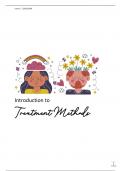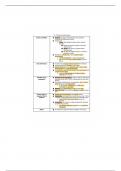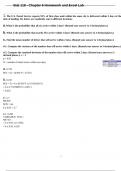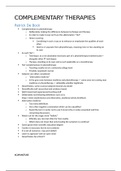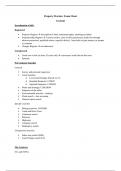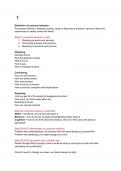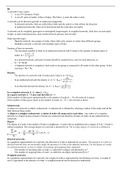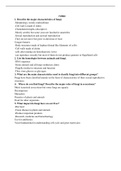Introduction to
Treatment Methods
1
,Laura C. | 2023/2024
This document summarizes the key concepts from the required course materials, including
the academic papers and lecture slides.
o passages that were straightforward and easy to understand were directly copied
from the original sources
o still, most of the material has been rewritten to be easier to understand and
remember, especially in preparation for the exam
o I’ve also incorporated tables, figures, and graphs to visually represent the
information
Good luck!
2
,Laura C. | 2023/2024
Contents
Lecture 1. Common factors in psychotherapy ........................................................................................ 8
What makes a common factor “common”? ................................................................................... 8
The contextual model (Wampold et al., 2015) ................................................................................... 8
Initial therapeutic relationship ....................................................................................................... 8
Pathway 1: The real relationship .................................................................................................... 9
Pathway 2: Expectations ................................................................................................................. 9
Pathway 3: Specific ingredients .................................................................................................... 10
Evidence for various common factors .............................................................................................. 10
Alliance .......................................................................................................................................... 10
Empathy and related constructs ................................................................................................... 12
Expectations .................................................................................................................................. 12
Cultural adaptation of evidence-based treatments...................................................................... 13
Therapist effects ........................................................................................................................... 13
Specific effects .................................................................................................................................. 14
Treatment differences .................................................................................................................. 14
Adherence and competence ......................................................................................................... 14
Lecture 1 slides ................................................................................................................................. 14
The (real) therapeutic relationship ............................................................................................... 15
Expectations .................................................................................................................................. 16
Transference as a threat for the therapeutic relationship ........................................................... 17
Lecture 2. Client-centered psychotherapy and emotion-focused therapy .......................................... 21
Carl Roger’s client-centred therapy .................................................................................................. 21
Roger’s theory or therapy ............................................................................................................. 21
The actualizing tendency .............................................................................................................. 21
The core conditions....................................................................................................................... 22
The nondirective attitude ............................................................................................................. 23
Roger’s theory of change .............................................................................................................. 23
Means and ends in therapy .......................................................................................................... 24
Client- initiated experiments and homework ............................................................................... 24
Emotion-focused therapy ................................................................................................................. 25
Principles of emotional change ..................................................................................................... 26
Markers and interventions............................................................................................................ 28
Phases of treatment...................................................................................................................... 29
The therapeutic tasks.................................................................................................................... 30
Principles of Change and Case Conceptualization ........................................................................ 32
3
,Laura C. | 2023/2024
Case conceptualization ................................................................................................................. 35
Assessment and Selection of Clients Assessment......................................................................... 37
Treatment ..................................................................................................................................... 37
Diversity ........................................................................................................................................ 40
Lecture 2 slides ................................................................................................................................. 41
Client-centered psychotherapy (CCP) ........................................................................................... 41
Emotion Focused Therapy ............................................................................................................ 44
Lecture 3. Psychodynamic psychotherapy............................................................................................ 48
Mentalization based treatment ........................................................................................................ 48
Borderline personality disorder (BPD) .......................................................................................... 48
Mentalization ................................................................................................................................ 48
Mentalization based treatment .................................................................................................... 49
Effectiveness of MBT..................................................................................................................... 51
Transference focused psychotherapy ............................................................................................... 51
Two approaches to borderline pathology..................................................................................... 51
Borderline pathology: structural organization.............................................................................. 52
Normal personality development and its deviations.................................................................... 53
Normal personality organization .................................................................................................. 54
Developmental factors.................................................................................................................. 55
Motivational aspects: affects and internal object relations ......................................................... 56
An object relations model of nosology ......................................................................................... 59
Neurotic personality organization ................................................................................................ 60
Borderline personality organization ............................................................................................. 60
Lecture 3 slides ................................................................................................................................. 66
Psychodynamic psychotherapy ..................................................................................................... 66
MBT: Mentalis(z)ation based therapy .......................................................................................... 67
TFP: transference focused therapy ............................................................................................... 68
TFP: interventions ......................................................................................................................... 69
The therapist’s attitude ................................................................................................................ 69
Lecture 4. Cognitive behavioural therapy (CBT) ................................................................................... 71
The theory underlying CBT................................................................................................................ 71
The basic principles of treatment ..................................................................................................... 72
The basics of CBT .............................................................................................................................. 75
Automatic thoughts ...................................................................................................................... 75
Rules and assumptions ................................................................................................................. 76
Core beliefs ................................................................................................................................... 77
4
,Laura C. | 2023/2024
CBT approaches to cognitive change ................................................................................................ 77
Identifying relations between thoughts, moods and behaviours ................................................. 77
Questioning and evaluating negative automatic thoughts........................................................... 78
Identifying and correcting cognitive distortions ........................................................................... 78
Recording your thoughts and targeting assumptions and beliefs ................................................ 79
Behavioural experiments .............................................................................................................. 80
CBT sessions ...................................................................................................................................... 80
Barriers to treatment ........................................................................................................................ 81
Medication? CBT? Both? ................................................................................................................... 81
CBT and mood disorders ................................................................................................................... 81
CBT and anxiety disorders................................................................................................................. 83
Exposure therapy .......................................................................................................................... 83
Cognitive therapy .......................................................................................................................... 84
Lecture 4 slides ................................................................................................................................. 84
1st wave: Behavioural therapy ...................................................................................................... 85
2nd wave: Cognitive therapy .......................................................................................................... 86
3rd wave: variants of traditional CBT including integration of acceptance models ...................... 87
CBT: basic principles...................................................................................................................... 87
The depression spiral .................................................................................................................... 88
Challenging thoughts .................................................................................................................... 89
CBT and anxiety disorder .............................................................................................................. 89
Generalized anxiety disorder ........................................................................................................ 91
Lecture 5. COMET (COMpetitive Memory Training) ............................................................................. 93
Lecture 5 slides ................................................................................................................................. 94
Lecture 6. Acceptance and commitment therapy (ACT)....................................................................... 96
The theoretical and philosophical basis of ACT ................................................................................ 96
ACT Philosophy: Functional Contextualism .................................................................................. 96
Basic ACT theory: relational frame theory .................................................................................... 97
Applied ACT theory: the implications of RFT ................................................................................ 97
Acceptance and commitment therapy goals .................................................................................... 98
Therapeutic assumptions and clinical stance ............................................................................... 99
Techniques .................................................................................................................................... 99
ACT vs other mindfulness- based approaches ............................................................................ 102
Experiential avoidance ................................................................................................................ 103
Therapeutic interventions............................................................................................................... 104
Core ACT interventions ............................................................................................................... 104
5
,Laura C. | 2023/2024
Six core principles of ACT ................................................................................................................ 105
The ACT therapeutic relationship ................................................................................................... 106
Lecture 6 slides ............................................................................................................................... 107
Psychological flexibility model .................................................................................................... 107
Acceptance and experiential avoidance ..................................................................................... 107
Values and committed action ..................................................................................................... 108
Cognitive defusion ...................................................................................................................... 109
ACT effectiveness ........................................................................................................................ 110
Lecture 7. Dialectical behavioural therapy (DBT) ............................................................................... 111
DBT theory ...................................................................................................................................... 111
How emotion dysregulation might be a common factor across many mental disorders .............. 113
DBT-modular treatment.................................................................................................................. 113
DBT and the algorithmic characteristic of behavioural assessment tasks ...................................... 118
Slides lecture 7 ................................................................................................................................ 121
DBT: assumptions........................................................................................................................ 122
The biosocial theory .................................................................................................................... 122
Treatment principles ................................................................................................................... 123
Balancing skills, treatment strategies and therapeutic positions ............................................... 124
Client’s needs in phase 1 of treatment ....................................................................................... 125
Chain analysis .............................................................................................................................. 126
Evidence for DBT’s effectiveness ................................................................................................ 127
Lecture 8. Eye movement desensitisation and reprocessing (EMDR) ................................................ 129
Do eye movements contribute to anything? .............................................................................. 130
Does EMDR work by stimulating ‘interhemispheric communication’? ...................................... 130
Does EMDR work by taxing working memory during recall?...................................................... 130
The effect of beeps ..................................................................................................................... 130
Slides lecture 8 ................................................................................................................................ 131
Basic premisses of EMDR ............................................................................................................ 131
Posttraumatic stress disorder (DSM-5) ....................................................................................... 132
Treatments for PTSD ................................................................................................................... 133
Advantages and disadvantages of EMDR.................................................................................... 133
Working mechanisms of EMDR................................................................................................... 134
EMDR protocol ............................................................................................................................ 135
Becoming an EMDR therapist ..................................................................................................... 136
Lecture 9. Schema therapy ................................................................................................................. 138
Early maladaptive schemas............................................................................................................. 139
6
,Laura C. | 2023/2024
Schema domains and early maladaptive schemas ......................................................................... 140
Schema operations ......................................................................................................................... 142
Schema modes ................................................................................................................................ 143
Adaptive schemas ........................................................................................................................... 146
Slides lecture 9 ................................................................................................................................ 149
Early maladaptive schemas ......................................................................................................... 149
Schema operations: perpetuation .............................................................................................. 152
Schema operations: healing ........................................................................................................ 154
Modes ......................................................................................................................................... 154
Schema assessment .................................................................................................................... 158
7
,Laura C. | 2023/2024
Lecture 1. Common factors in psychotherapy
Wampold, B. E. (2015). How important are the common factors
in psychotherapy? An update. World Psychiatry, 14(3), 270-277.
https://www.ncbi.nlm.nih.gov/pmc/articles/PMC4592639/
- the common factors are the factors that collectively shape a
theoretical model about the mechanisms of change in
psychotherapy
- research over time (using RCT’s1) focussed on “which therapy is better”, but in
general all provide similar outcomes; this raises the question: Do different types of
psychotherapy matter, or are the changes acquired through general/“common
factors” which are present in all psychotherapy in general?
What makes a common factor “common”?
- although treatment methods differ in their approach (e.g., with different
interventions, therapist attitudes, vocabulary, assumptions etc), the general belief is
that there are also measurable, yet not always perceivable mechanisms at work that
contribute towards change in people
- They are common mechanisms in most people and it is expected to be part of our
socio- biological heritage => in psychotherapy we have patient factors and therapist
factors
The contextual model (Wampold et al., 2015)
- the contextual model posits that there are three pathways through which
psychotherapy produces benefits; this means that psychotherapy does not have a
unitary influence on patients, but rather works through various mechanisms
these three pathways are:
o the real therapeutic relationship
o the creation of expectations through explanation of disorder and the treatment
involved
o the enactment of health promoting actions
Initial therapeutic relationship
- before the work of therapy can begin, an initial bond between therapist and patient
needs to be created; the initial interaction between patient and therapist is critical
because more patients prematurely terminate from therapy after the first session
than at any other point
- the first meeting between a patient and therapist is essentially a meeting between
two individuals who are unfamiliar with each other- during this encounter, the
patient assesses whether the therapist is reliable, possesses the required expertise,
and is willing to invest the time and effort to comprehend both the issue and the
surrounding circumstances of the patient
1
randomized controlled trials
8
,Laura C. | 2023/2024
- the establishment of the first connection involves a blend of both bottom-up and
top-down cognitive processes; considering that within a mere 100 milliseconds,
humans can swiftly assess the trustworthiness of another individual simply by
looking at their face, patients also similarly form quick judgments about their
therapist's trustworthiness
- expectations also play a role in forming the bond between patient and therapist:
patients come to therapy with expectations about the nature of psychotherapy due
to prior experiences, recommendations of intimate or influential others, cultural
beliefs, and so forth
Pathway 1: The real relationship
- the real relationship= “the personal relationship between therapist and patient
marked by the extent to which each is genuine with the other and
perceives/experiences the other in ways that befit the other”
- the therapeutical relationship is an unusual social relationship because:
o the interaction is confidential, with some statutory limits (e.g., child abuse
reporting)
o disclosure of difficult material (e.g., of infidelity to a spouse, of shameful affect,
and so forth) does not disrupt the social bond
=> in psychotherapy, the patient is able to talk about difficult topics without the
threat that the therapist will terminate the relationship
Pathway 2: Expectations
- expectations have a strong influence on experience
- patients in therapy typically hold their own psychological beliefs, often referred to as
"folk psychology"; these beliefs, influenced by both cultural norms and personal
experiences, are usually not conducive to finding solutions to their distress
- psychotherapy aims to offer an alternative explanation for the patient's difficulties
that is more adaptive, providing strategies to overcome or manage their issues =>
through therapy, patients develop the belief that engaging in therapy tasks can aid in
coping with their problem which fosters the expectation that they possess the ability
to implement necessary actions to address their challenges.
- to discuss this belief in one's capability to solve problems various psychological
concepts, such as mastery, self-efficacy, or response expectancies, have been used
- patients' belief in the effectiveness of explanations and treatment actions is crucial
for the expectation pathway
- agreement between the patient and therapist on therapy goals and tasks is essential
- there are two critical components of the therapeutic alliance:
o shared goals of therapy
o agreement of therapy tasks
- expectations in psychotherapy depend on:
o a clear theoretical explanation provided to the patient
o acceptance of this explanation by the patient
o consistent therapeutic activities aligned with the explanation
9
, Laura C. | 2023/2024
o patient belief that these activities will empower them to manage their problems
effectively
Pathway 3: Specific ingredients
- each cogent2 treatment contains certain well specified therapeutic actions;
according to the contextual model, if the treatment elicits healthy patient actions, it
will be effective
- the contextual model proposes that the specific ingredients not only create
expectations (pathway 2), but universally produce some salubrious3 actions (=the
therapist induces the patient to enact some healthy actions)
e.g.: thinking about the world in less maladaptive ways and relying less on
dysfunctional schemas (cognitive-behavioural treatments)
improving interpersonal relations (interpersonal psychotherapy and some dynamic
therapies)
being more accepting of one’s self (self-compassion therapies, acceptance and
commitment therapy)
expressing difficult emotions (emotion-focused and dynamic therapies)
taking the perspective of others (mentalization therapies), etc.
Evidence for various common factors
alliance
empathy
expectations
therapist effects
cultural adaptation of evidence-based treatments
treatment differences
adherence and competence
Alliance
- the alliance is composed of three components:
o the bond
o the agreement about the goals of therapy
o the agreement about the tasks of therapy (goal consensus/collaboration)
the bond is related to purposeful work
the real relationship is focused on the transference-free genuine relationship
between therapist and patient
- typically, the alliance is measured early in therapy (at session 3 or 4) and correlated
with final outcome; studies indicate that there’s a medium sized effect when it
comes to the correlations between alliance and therapeutical outcome
- criticism of the conclusion that alliance is an important factor in psychotherapy:
2
clear, logical
3
health-giving; healthy
10


